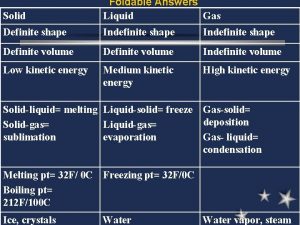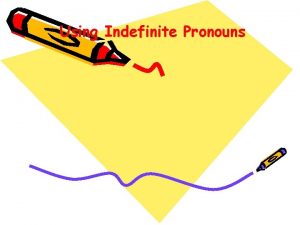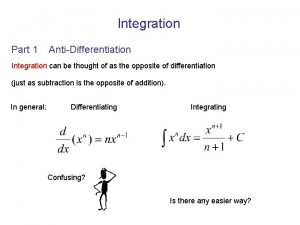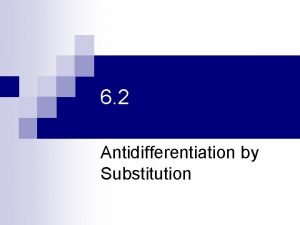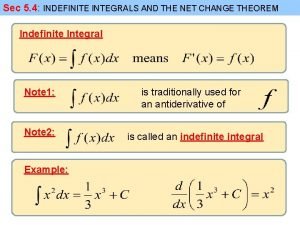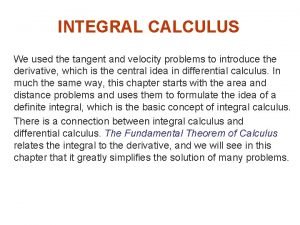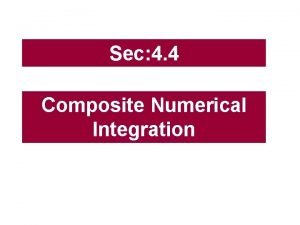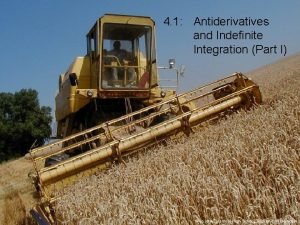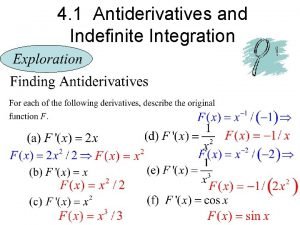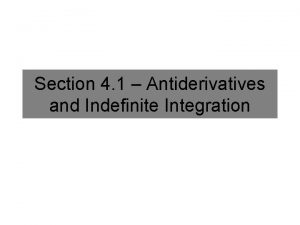Sec 4 1 Antiderivatives and Indefinite Integration Antidifferentiation














- Slides: 14

Sec. 4. 1 Antiderivatives and Indefinite Integration

Antidifferentiation is the art of finding the function F(x) whose derivative would be the given function F /(x). Antidifferentiation is also called: Indefinite Integration Just as represents finding a derivative, the symbol represents finding the antiderivative of the function f(x). The symbol is called the integral symbol and resembles an elongated s which as we will see in the next section is associated with finding sums. The dx shows what variable we are integrating.

For most of the examples, you will be using the exponent formula which is like the opposite of the power formula.

Initial Conditions and Particular Solutions When we find antiderivatives and add the constant C, we are creating a family of curves for each value of C. C=0 C=1 C=3

Finding a Particular Solution Find the general solution of General Solution means the antiderivative + C. A particular solution means that given some helpful information we will find the value of C. The following information is referred to as the initial condition: F(1) = 0 C=1

Setting Up A Vertical Motion Problem When you must set up the motion of a falling object, S is the position function, is the velocity function, and is the acceleration function. Acceleration due to gravity is -32 ft. per second. Begin most problems with:

A ball is thrown upward with an initial velocity of 64 feet per second from an initial height of 80 feet. A. Find the position function giving the height S as a function of the time t. B. When does the ball hit the ground? Begin by integrating The initial velocity is 64 feet per second. This means at t = 0, S’ = 64 The initial height means at t = 0, S = 80

C = 80 Thus, the position function is: B. When will the ball hit the ground? When S = 0 Since t must be positive, the ball hit the ground after 5 seconds.

Sample Problems:

Solve the differential equation: Find f(x) Integrate: Substitute x=0 and 6 for f’(0) Thus c = 6 Integrate again: Substitute x = 0 and f(0)=3 Answer: C=3

Vertical Motion: Use a(t)=-32 feet per sec as the acceleration due to gravity. (Neglect air resistance. ) A balloon rising vertically with a velocity of 16 feet per second, releases a sandbag at the instant it is 64 feet above the ground. (a) How many seconds after its release will the bag strike the ground? (b) At what velocity will it hit the ground? Solution: Begin with a(t) = -32 and integrate. Remember v’(t)=a(t), thus v(t)= -32 t + c. At t = 0 (the moment the sandbag is released, the balloon has a velocity of 16, thus 16 = c. v(t) = -32 t + 16 Continued on next page

60 continued v(t) = -32 t + 16 Now integrate v(t) which is s(t) the position function. S(t)= -16 t 2 + 16 t + c A balloon rising vertically with a velocity of 16 feet per second, releases a sandbag at the instant it is 64 feet above the ground. At t = 0, s(t) is 64 feet above the ground. Thus c = 64 and s(t) = -16 t 2 + 16 t + 64 (a) How many seconds after its release will the bag strike the ground? The position of the bag indicates that s = 0 on ground.

s(t) = -16 t 2 + 16 t + 64 0 = -16(t 2 - t - 4) 0 = t 2 - t - 4 Since this doesn’t factor we will need to use the quadratic formula to solve. One of these t’s is negative. One is positive. We want the positive answer. t = 2. 56 approximately Thus the sandbag is on the ground in about 2. 6 seconds

(b) At what velocity will it hit the ground? v(t) = -32 t + 16 @ t = 2. 56 v(2. 56) = -32(2. 56) + 16 = -65. 92 The velocity of the sandbag when it hits the ground is approximately -65. 92 feet per second.
 Integration and antidifferentiation
Integration and antidifferentiation Antiderivatives
Antiderivatives Antidifferentiation vs integration
Antidifferentiation vs integration Indefinite shape and indefinite volume
Indefinite shape and indefinite volume Indefinite adjectives
Indefinite adjectives Antidifferentiation rules
Antidifferentiation rules Integration examples
Integration examples Antiderivative calculator
Antiderivative calculator Antidifferentiation by substitution
Antidifferentiation by substitution Indefinite integral and definite integral
Indefinite integral and definite integral Integral symmetry
Integral symmetry Integration of sec
Integration of sec Three dimensions of corporate strategy
Three dimensions of corporate strategy Forward and backward integration
Forward and backward integration Simultaneous integration example
Simultaneous integration example



